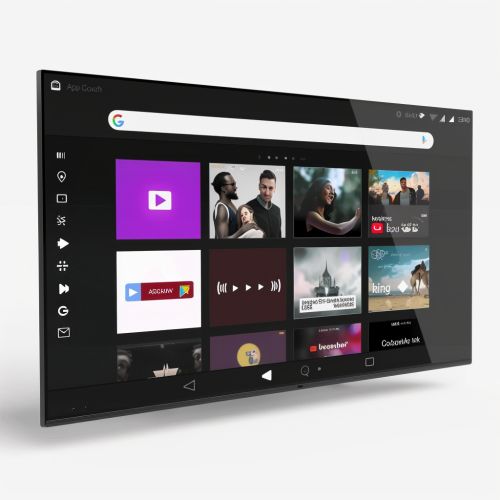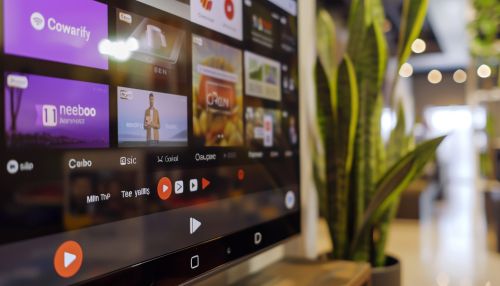Android TV: Difference between revisions
(Created page with "== Overview == '''Android TV''' is a smart TV operating system developed by Google, based on the Android platform. Introduced in June 2014, Android TV extends the Android operating system to televisions, digital media players, set-top boxes, and soundbars. It provides a user interface designed for the 10-foot user experience, integrating with Google services such as Google Assistant and Google Cast. == History and Development == Android TV was first announced at Google...") |
No edit summary |
||
| Line 9: | Line 9: | ||
The Android TV interface is designed for ease of navigation with a remote control. The home screen features a row-based layout, with content recommendations from installed apps displayed prominently. The interface supports voice search, allowing users to find content using Google Assistant. | The Android TV interface is designed for ease of navigation with a remote control. The home screen features a row-based layout, with content recommendations from installed apps displayed prominently. The interface supports voice search, allowing users to find content using Google Assistant. | ||
[[Image:Detail-92845.jpg|thumb|center|Android TV interface displaying various streaming apps and content recommendations.|class=only_on_mobile]] | |||
[[Image:Detail-92846.jpg|thumb|center|Android TV interface displaying various streaming apps and content recommendations.|class=only_on_desktop]] | |||
=== Google Assistant Integration === | === Google Assistant Integration === | ||
Latest revision as of 17:07, 21 June 2024
Overview
Android TV is a smart TV operating system developed by Google, based on the Android platform. Introduced in June 2014, Android TV extends the Android operating system to televisions, digital media players, set-top boxes, and soundbars. It provides a user interface designed for the 10-foot user experience, integrating with Google services such as Google Assistant and Google Cast.
History and Development
Android TV was first announced at Google I/O 2014 as a successor to the earlier Google TV platform. The initial release aimed to simplify the user experience and integrate more closely with the Android ecosystem. The platform has since undergone several iterations, with significant updates introduced in Android versions Lollipop (5.0), Marshmallow (6.0), Nougat (7.0), Oreo (8.0), and Pie (9.0).
Features
User Interface
The Android TV interface is designed for ease of navigation with a remote control. The home screen features a row-based layout, with content recommendations from installed apps displayed prominently. The interface supports voice search, allowing users to find content using Google Assistant.


Google Assistant Integration
Google Assistant is deeply integrated into Android TV, enabling voice commands for searching content, controlling playback, and managing smart home devices. Users can activate Google Assistant via a dedicated button on the remote control or through voice commands.
Google Cast Support
Android TV includes built-in support for Google Cast, allowing users to cast content from their mobile devices or computers to the TV. This feature is similar to the functionality provided by Chromecast devices.
App Ecosystem
Android TV supports a wide range of apps available through the Google Play Store. These include popular streaming services like Netflix, Hulu, Amazon Prime Video, and YouTube, as well as games and utility apps. Developers can create apps specifically optimized for the Android TV platform using the Android SDK.
Gaming
Android TV supports gaming through the Google Play Store, with many games optimized for the platform. It also supports game controllers, providing a console-like gaming experience. The platform is compatible with cloud gaming services such as Google Stadia and NVIDIA GeForce Now.
Customization and Personalization
Users can customize the Android TV home screen by rearranging app rows and selecting preferred content sources. The platform also supports user profiles, allowing different family members to have personalized recommendations and settings.
Hardware and Devices
Android TV is available on a variety of devices, including smart TVs, set-top boxes, and streaming sticks. Major manufacturers such as Sony, Philips, Sharp, and TCL offer Android TV-powered smart TVs. Additionally, devices like the NVIDIA Shield TV and Xiaomi Mi Box provide Android TV functionality for existing televisions.
Technical Specifications
System Requirements
Android TV requires specific hardware configurations to ensure optimal performance. Minimum requirements typically include a quad-core processor, 2GB of RAM, and 8GB of internal storage. The platform supports 4K resolution and HDR content, provided the hardware meets the necessary specifications.
Software Development Kit (SDK)
The Android TV SDK allows developers to create apps optimized for the platform. The SDK includes tools for designing user interfaces, handling input from remote controls and game controllers, and integrating with Google services. Developers can test their apps using the Android TV emulator or physical devices.
Security and Privacy
Android TV incorporates several security features to protect user data and ensure a safe experience. These include regular security updates, app permissions management, and support for secure boot and verified boot processes. Users can control privacy settings, such as location access and personalized ads, through the system settings.
Market Adoption and Competitors
Since its launch, Android TV has gained significant market share, particularly in the smart TV segment. It competes with other smart TV platforms such as Roku, Apple TV, and Amazon Fire TV. Android TV's integration with Google services and the extensive app ecosystem are key differentiators in the market.
Future Developments
Google continues to evolve Android TV with new features and improvements. Future updates are expected to enhance the user interface, expand Google Assistant capabilities, and introduce new developer tools. The platform is also likely to see increased integration with other Google products and services, such as Google Home and Nest devices.
